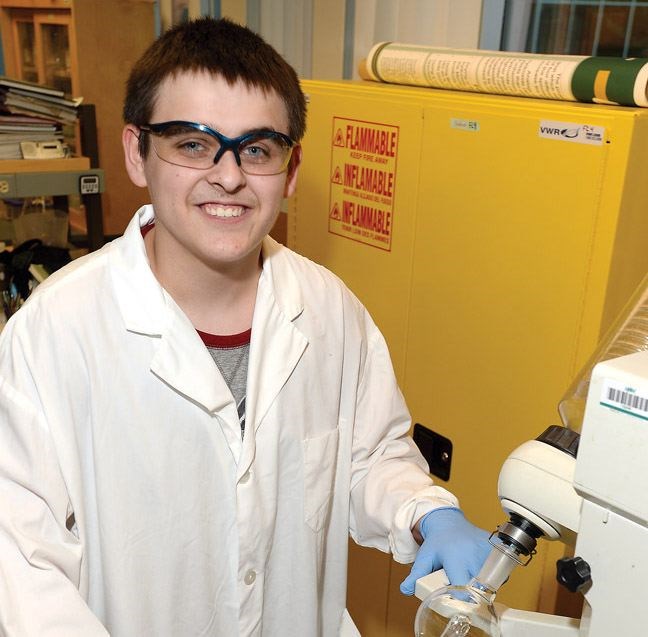A Prince George student is one of two Canadians selected to compete in an international science fair this January.
The genesis of Daniel O'Reilly's project can be traced to an ear infection.
Last year, he started to feel the familiar ache and got to talking with his mother about possible remedies. As a child, he was plagued by the infections and his grandfather would suggest a tactic used in his Croatian village.
"He grew up in a small town with no antibiotics so he would use the natural resources around him," explained O'Reilly, a Grade 11 College Heights Secondary School student who is headed to the Taiwan International Science Fair.
"He would grab moss from the roof and he would grab cloth and pour warm water over top and he would wring it out inside of his ear and he always claimed this would get rid of the bacteria," said O'Reilly. "I wanted to see if grampa's home remedy would be valid."
So the 16-year-old got to work.
He tested two species of moss as well as two species of trees - including eight varieties - to see how they reacted to bacteria. He tried them on bacteria connected to ear infections, sinus infections, strep throat and E. coli.
Using University of Northern B.C. organic chemistry professor Guy Plourde's teaching lab, he ground the trees into sawdust and then tested both the solid and a solution of each against bacteria placed in an agar plate.
"We wanted to see if it would stop the growth of the bacteria - so inhibit it," O'Reilly said.
The moss yielded no results and so did seven of the eight tree varieties.
"We would take all of the different plates out of the incubator, and we would be flipping over each one for the zones of inhibition," he said, showing the pictures of the plates in a big binder of the plates with a little dot in the centre, but no sign that there was a reaction. "You would flip a bunch of them and you would have nothing."
O'Reilly remembered the moment when he looked at that eighth tree and there they were: wide circles spreading out from the drop of tree extract - the zones of inhibition.
That was the best feeling, he said.
But with both moss test showing negative results, O'Reilly was disappointed.
Then something clicked.
His mother, Mary, said he came running out of the shower asking of pictures of his grandfather's old home.
"I was looking for wood pictures. I found a picture of my great-great grandparents in front their house of Croatia," said O'Reilly, pointing the figures snapped in a black and white frame. "In the back you can see they had wood tile shingling."
It was the same type of wood that worked on the bacteria.
"The home remedy could still be valid because it could have been the moss that was growing on the... tree shingles," said O'Reilly with a smile.
That'll take more testing, but at least his hypothesis - and his grandfather's remedy - is still in play. O'Reilly is keeping the type of wood under wraps until he does more research.
O'Reilly learned his project earned him a ticket to the Taiwan fair last month.
"It was pretty amazing," said O'Reilly.
It won't be all new territory. O'Reilly went to Taiwan last year when his sister Emily, then in Grade 12, won first place for her project, which also tested one of their grandfather's folk remedies.
O'Reilly's also a science fair veteran. Since Grade 7, he's medalled in every national compeition. But it all started when he won his first gold medal in Grade 4.
"After that I guess it just was the fuel for the fire and sparked the curiosity to keep going," said O'Reilly to explain the hundreds of hours he's spent on the one project alone this last year.
For his mother, it's made such a difference having the support of mentors at Prince George's two post-secondary institutions.
"Without Dr. Plourde and Yvonne Yaschuk at CNC, projects like this wouldn't really happen for students in our community," said Mary.
Plourde works with O'Reilly purely to promote a similar love in science, saying he likes making students "sit up in their chair" as they learn something new.
"For me this is the human aspect rather than science, it's getting somebody in the right direction to do science and think about it properly. That's the part that excites me the most."
Plourde's also proud to be offering that kind of support through the university.
"This is a really good example of UNBC participating in the community. We're not just on top of the hill," Plourde said. "That's one of the reasons I like to do it. Community work is not just going to high school and saying 'why don't you come to UNBC?' This is helping something in a very specific way that makes (something) the whole northern B.C. - Prince George, UNBC - should be proud of: somebody from here is going internationally trying to represent us and hopefully win."



